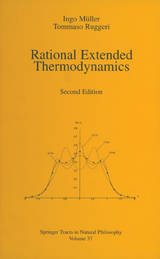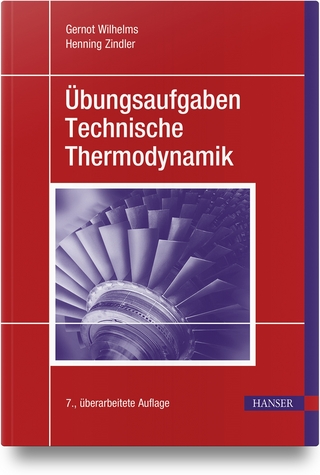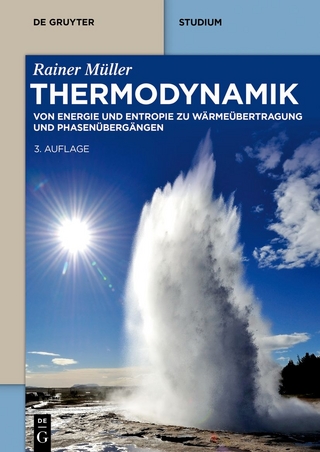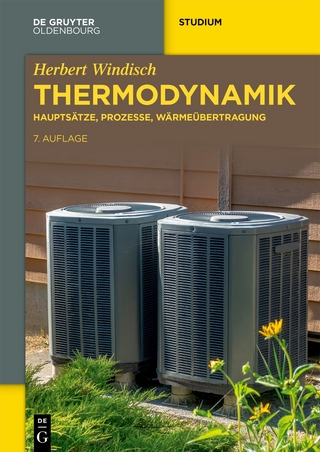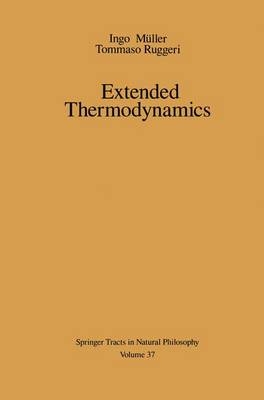
Extended Thermodynamics
Springer-Verlag New York Inc.
978-0-387-97922-9 (ISBN)
- Titel ist leider vergriffen;
keine Neuauflage - Artikel merken
Physicists firmly believe that the differential equations of nature should be hyperbolic so as to exclude action at a distance; yet the equations of irreversible thermodynamics - those of Navier-Stokes and Fourier - are parabolic. This incompatibility between the expectation of physicists and the classical laws of thermodynamics has prompted the formulation of extended thermodynamics. After describing the motifs and early evolution of this new branch of irreversible thermodynamics, the authors apply the theory to mon-atomic gases, mixtures of gases, relativistic gases, and "gases" of phonons and photons. The discussion brings into perspective the various phenomena called second sound, such as heat propagation, propagation of shear stress and concentration, and the second sound in liquid helium. The formal mathematical structure of extended thermodynamics is exposed and the theory is shown to be fully compatible with the kinetic theory of gases. The study closes with the testing of extended thermodynamics through the exploitation of its predictions for measurements of light scattering and sound propagation.
1 Early Version of Extended Thermodynamics and Kinetic Theory of Gases.- 1 Paradoxa of Heat Conduction and Shear Diffusion.- 1.1 Heuristic Derivation of the Laws of Fourier and Navier-Stokes.- 1.2 Parabolic Laws of Heat Conduction and Shear Diffusion.- 2 Paradox Removed.- 2.1 The Cattaneo Equation.- 2.2 Extended TIP.- 2.3 Finite Pulse Speeds in Extended TIP.- 2.4 Conclusion and Criticism.- 3 Kinetic Theory of Mon-Atomic Gases.- 3.1 Boltzmann Equation and Moments.- 3.2 Equations of Balance for Moments.- 3.3 Balance of Entropy and Possible Equilibria.- 3.4 The Grad Distribution.- 3.5 Entropy and Entropy Flux in Grad’s 13-Moment Theory.- 3.6 Phenomenological Equations Derived from the Kinetic Theory.- 3.7 Pulse Speeds.- 3.8 Conclusions.- 2 Extended Thermodynamics of Mon-Atomic Gases.- 1 The Equations of Extended Thermodynamics of Mon-Atomic Gases.- 1.1 Thermodynamic Processes.- 1.2 Discussion.- 1.3 Galilean Invariance: Convective and Non-Convective Fluxes.- 1.4 Euclidean Invariance: Inertial Effects.- 2 Constitutive Theory.- 2.1 Restrictive Principles.- 2.2 Exploitation of the Principle of Material Frame Indifference.- 2.3 Exploitation of the Entropy Principle.- 2.4 Exploitation of the Requirement of Convexity and Causality.- 3 Field Equations and the Thermodynamic Limit.- 3.1 Field Equations.- 3.2 The Thermodynamic Limit.- 3.3 The Frame-Dependence of the Heat Flux.- 4 Thermal Equations of State and Specific Equation for Ideal Gases.- 4.1 The Classical Ideal Gas.- 4.2 Comparison with the Kinetic Theory.- 4.3 Comparison with Extended TIP.- 4.4 Degenerate Ideal Gases.- 3 Thermodynamics of Mixtures of Fluids.- 1 Ordinary Thermodynamics of Mixtures (TIP).- 1.1 Constitutive Equations.- 1.2 Paradox of Diffusion.- 2 Extended Thermodynamics of Non-Viscous Simple Mixtures.- 2.1 Balance Equations.- 2.2 Thermodynamic Processes.- 2.3 Constitutive Theory.- 2.4 Summary of Results.- 2.5 Wave Propagation in a Non-Reacting Binary Mixture.- 2.6 Landau Equations: First and Second Sound in He II.- 3 Ordinary and Extended Thermodynamics of Mixtures.- 3.1 The Laws of Fick and Fourier in Extended Thermodynamics.- 3.2 Onsager Relations.- 3.3 Inertial Contribution to the Laws of Diffusion.- 4 Relativistic Extended Thermodynamics of Mon-Atomic Gases.- 1 Balance Equations and Constitutive Restrictions.- 1.1 Thermodynamic Processes.- 1.2 Principles of the Constitutive Theory.- 2 Constitutive Theory.- 2.1 Scope and Structure.- 2.2 Lagrange Multipliers and the Vector Potential.- 2.3 Principle of Relativity and Linear Representations.- 2.4 Stress Deviator, Heat Flux, and Dynamic Pressure.- 2.5 Fugacity and Absolute Temperature.- 2.6 Linear Relations Between Lagrange Multipliers and n, UA, t, ?, qA, e.- 2.7 The Linear Flux Tensor.- 2.8 The Entropy Flux Vector.- 2.9 Residual Inequality.- 2.10 Causality and Convexity.- 2.11 Summary of Results.- 3 Identification of Viscosities and Heat Conductivity.- 3.1 Extended Thermodynamics and Ordinary Thermodynamics.- 3.2 Transition from Extended to Ordinary Thermodynamics.- 4 Specific Results for Relativistic and Degenerate Gases.- 4.1 Equilibrium Distribution Function.- 4.2 The Degenerate Relativistic Gas.- 4.3 Non-Degenerate Relativistic Gas.- 4.4 Degenerate Non-Relativistic Gas.- 4.5 Non-Degenerate Non-Relativistic Gas.- 4.6 Strongly Degenerate Relativistic Fermi Gas.- 4.7 A Remark on the Strongly Degenerate Relativistic Bose Gas.- 4.8 Equilibrium Properties of an Ultrarelativistic Gas.- 5 Two Applications.- 5.1 The Limit Mass of White Dwarfs.- 5.2 Thermo Acceleration Waves.- 6 The Relativistic Kinetic Theory for Non-Degenerate Gases.- 6.1 Boltzmann—Chernikov Equation.- 6.2 Equations of Transfer.- 6.3 Equations of Balance for Particle Number, Energy-Momentum, Fluxes, and Entropy.- 6.4 Maxwell-Jüttner Distribution: Equilibrium Properties.- 6.5 Possible Thermodynamic Fields in Equilibrium.- 7 The Non-Relativistic Limit of Relativistic Thermodynamics.- 7.1 The Problem.- 7.2 Variables and Constitutive Quantities.- 7.3 The Dynamic Pressure.- 5 Thermodynamics of Light and Sound.- 1 Phonons and Photons.- 1.1 Cavity Radiation and Sound in Single Crystals.- 1.2 Thermodynamic Processes.- 1.3 Motivations.- 1.4 Principles of the Constitutive Theory: The Entropy Inequality.- 1.5 Exploitation of the Entropy Principle.- 2 Energy and Momentum of Light and Sound.- 2.1 Eddington Factor, Entropy, and Entropy Flux.- 2.2 Summary of Results and Limiting Cases.- 2.3 Waves.- 3 Shock Waves.- 3.1 Rankine Hugoniot Equations and the Speed of Shock Waves.- 3.2 Entropy Criterion for the Admissibility of Shock Waves.- 6 Formal Structure of Extended Thermodynamics.- 1 The Formal Structure of Extended Thermodynamics.- 1.1 The Axioms of Extended Thermodynamics: Thermodynamic Processes.- 1.2 Universal Principles of the Constitutive Theory.- 1.3 Exploitation of the Entropy Principle.- 1.4 Symmetric Hyperbolic Field Equations.- 2 Galilean Invariance.- 2.1 Euclidean Transformations, Galilean Transformations, and Rotations.- 2.2 Explicit Dependence of Constitutive Quantities on Velocity.- 2.3 Galilean Invariance and Entropy Principle.- 3 Variables of Increasing Tensorial Rank.- 3.1 Restrictive Conditions on the Matrices X(v) and Ar.- 3.2 The Case N = 3: An Illustration.- 3.3 The Matrix X(v) for Arbitrary N.- 7 Waves in Extended Thermodynamics.- 1 Hyperbolicity and Symmetric Hyperbolic Systems.- 1.1 Hyperbolicity in the t-Direction.- 1.2 Symmetric Hyperbolic Systems.- 2 Linear Waves.- 2.1 Plane Harmonic Waves: The Dispersion Relation.- 2.2 The High Frequency Limit.- 2.3 Higher-Order Terms.- 2.4 Linear Waves in Extended Thermodynamics.- 3 Hyperbolicity in Extended Thermodynamics.- 3.1 The Characteristic Polynomial.- 3.2 Region of Hyperbolicity.- 4 Non-Linear Waves, Discontinuity Waves, or Acceleration Waves.- 4.1 Amplitude of Discontinuity Waves.- 4.2 Growth and Decay.- 4.3 Evolution of Amplitude in Extended Thermodynamics.- 5 Non-Linear Waves and Shock Waves.- 5.1 Weak Solutions.- 5.2 Rankine-Hugoniot Equations.- 5.3 Shocks in Extended Thermodynamics.- 5.4 Selection Rules for Physical Shocks: The Entropy Growth Condition.- 5.5 Selection Rules for Physical Shocks: The Lax Conditions.- 5.6 Lax Condition in Extended Thermodynamics.- 8 Second Sound in Solids at Low Temperature.- 1 Extended Thermodynamics of Phonons Generalized.- 1.1 Equations of Balance and Constitutive Equations.- 1.2 Entropy Principle.- 1.3 Adjusting v’ to Observed Wave Speeds.- 1.4 An Analytic Form of UE(T).- 2 Shock Waves in a Rigid Conductor.- 2.1 Rankine-Hugoniot Equations.- 2.2 Entropy Growth Condition.- 2.3 Lax Conditions.- 2.4 Shape Changes of Second Sound Wave.- 9 Molecular Extended Thermodynamics.- 1 Field Equations of Molecular Extended Thermodynamics of Many Moments.- 1.1 Densities, Fluxes, and Productions as Moments of the Phase Density.- 1.2 Maximizing Entropy.- 1.3 Molecular Extended Thermodynamics Implies Extended Thermodynamics.- 1.4 Galilean Invariance and Central Moments.- 1.5 Linear Relation Between Lagrange Multipliers ?? and Fields u?.- 1.6 The Case n = 20: An Illustration.- 1.7 Field Equations for n = 13, 14, 20, 21, 26, 35.- 2 More Kinetic Theory.- 2.1 Boltzmann Equation and Transfer Equations.- 2.2 Linearized Kinetic Theory.- 2.3 Eigenfunctions and Eigenvalues for Maxwellian Atoms.- 3 Equations for Mean Eigenfunctions and Closure.- 3.1 Mean Eigenfunctions.- 3.2 Field Equations for Mean Eigenfunctions and Closure.- 4 Molecular Extended Thermodynamics and Method of Eigenfunctions.- 4.1 Phase Density in Molecular Extended Thermodynamics.- 4.2 Lagrange Multipliers as Expansion Coefficients.- 10 Testing Extended Thermodynamics by Light.- 1 Basic Electrodynamics.- 1.1 Distant Field Approximation.- 1.2 Incident Plane Harmonic Wave.- 1.3 Intensity of Scattered Light.- 2 Auto-Correlation Function as the Characteristic Feature of a Fluctuating Quantity.- 2.1 The Simplest Case: One Real Fluctuating Quantity.- 2.2 Several Complex Fluctuating Quantities.- 3 The Spectral Density: A Measurable Quantity.- 3.1 Auto-Correlation Function of the Scattered Field.- 3.2 Spectral Density and Dynamic Form Factor.- 4 Onsager Hypothesis.- 4.1 Statement.- 4.2 Field Equations of a Navier-Stokes-Fourier Fluid.- 4.3 Solution of the Field Equations.- 5 Auto-Correlation Function and Its Properties.- 5.1 The Dynamic Form Factor.- 5.2 Alternative Form of the Dynamic Form Factor and the Auto-Correlation Function.- 5.3 Form Factor and Auto-Correlation Function in Forward Scattering.- 5.4 Heat Modes and Sound Modes.- 6 How to Use Light Scattering.- 6.1 Two Philosophies.- 6.2 Dimensionless Parameters and Limiting Characteristics.- 7 Light Scattering and Extended Thermodynamics.- 7.1 The Case of 13 Moments: An Illustration.- 7.2 Comparison of the Navier-Stokes-Fourier Theory and of Extended Thermodynamics of 13 and 14 Moments.- 7.3 Extended Thermodynamics with More and More Moments.- 11 Testing Extended Thermodynamics by Sound.- 1 Basic Acoustics.- 1.1 How the Acoustic Resonator Measures Phase Speeds in Principle.- 1.2 Piezoelectric Transducer and the Mechanical Impedance.- 1.3 External Mechanical Impedance and Wave Length.- 1.4 Difficulties with Many Modes and Damping.- 2 Dispersion Relations.- 2.1 Navier-Stokes-Fourier Theory.- 2.2 Extended Thermodynamics of 13 Fields.- 2.3 Extended Thermodynamics with Many Variables.- 2.4 Interpretation and Criticism.- 3 Maximum Speed.- 3.1 Modes of Least Damping.- 3.2 The Maximum Speed.
| Erscheint lt. Verlag | 12.3.1993 |
|---|---|
| Reihe/Serie | Springer Tracts in Natural Philosophy ; 0037 |
| Zusatzinfo | Bibliography |
| Verlagsort | New York, NY |
| Sprache | englisch |
| Maße | 163 x 242 mm |
| Gewicht | 535 g |
| Themenwelt | Mathematik / Informatik ► Informatik |
| Naturwissenschaften ► Physik / Astronomie ► Thermodynamik | |
| Schlagworte | Springer Tracts in Natural Philosophy; v. 37 |
| ISBN-10 | 0-387-97922-0 / 0387979220 |
| ISBN-13 | 978-0-387-97922-9 / 9780387979229 |
| Zustand | Neuware |
| Informationen gemäß Produktsicherheitsverordnung (GPSR) | |
| Haben Sie eine Frage zum Produkt? |
aus dem Bereich
